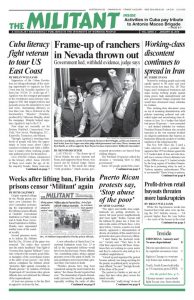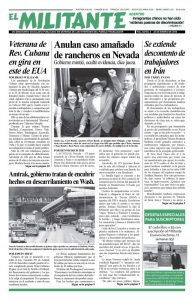HAVANA — “Today we are celebrating 40 years of continuous activity” defending the Cuban Revolution in the United States, said Andrés Gómez, national coordinator of the Antonio Maceo Brigade. He was speaking at a Dec. 19 event here honoring the work of the brigade. Held at the headquarters of the Cuban Institute for Friendship with the Peoples (ICAP), the celebration was attended by 150 people.
The meeting was part of a three-day program of activities for a delegation of nearly 50 members of the Antonio Maceo Brigade and the Alianza Martiana coalition. Most of them are Cubans living in the U.S. Two came from France.

The brigade is a Miami-based organization of Cubans founded in 1977 that opposes Washington’s hostile policies against the Cuban Revolution. Today it is part of the Alianza Martiana (Martí Alliance, after Cuban national hero José Martí), a coalition of Cuban groups formed in Miami in 2000.
Speaking at the ICAP-sponsored event, Gómez noted that over the years the brigade and Alianza Martiana have organized many public activities — including numerous car caravans through Cuban neighborhoods in Miami — as part of the fight to lift all U.S. sanctions against Cuba. Ending restrictions on travel by Cuban-Americans to visit their families has been an important part of that campaign.
The groups played an active role in the international campaign that by 2014 won the release of five Cuban revolutionaries framed up and imprisoned by Washington, known here as the Five Heroes. And they have persistently defended the right of opponents of U.S. government policies toward Cuba to gather publicly and speak out, defying physical attacks and threats by counterrevolutionary Cuban forces.
The Dec. 19 tribute to the Antonio Maceo Brigade was attended by a number of Cuban leaders and others who have worked with the organization over the years. Among them were four of the Five Heroes — Gerardo Hernández, Antonio Guerrero, Fernando González, and René González, along with many of their family members.
Fernando González, who is today president of ICAP, noted that despite attacks by rightists, brigade members “have never wavered in their support to the revolution.” He said the group’s efforts to strengthen ties between Cubans abroad and on the island have helped reinforce the Cuban government’s approach “that our emigrants are an essential part of the Cuban homeland.”
The delegates took part in a range of events. These included a press conference, a visit to an elementary school and an exchange with students at the University of Havana, as well as conferences on the economic challenges the Cuban people face today, U.S.-Cuba relations, the Cuban leadership’s response to Hurricane Irma and the revolution’s advances in the development of medicines.
They took part in a ceremony at the monument to Antonio Maceo, a central leader of Cuba’s 19th century independence wars, who was black. They also visited the historic Colón cemetery to honor the memory of Brigade members, some of whom were murdered by counterrevolutionary Cuban groups, and other pro-revolution Cubans resident in the United States who are buried there.
Among the Cuban leaders who attended these events were José Ramón Balaguer, head of the Cuban Communist Party’s international relations department; Josefina Vidal, director of U.S. affairs at Cuba’s foreign ministry; and Ricardo Alarcón, former president of Cuba’s National Assembly and previously Cuban ambassador to the United Nations.
Groundbreaking 1977 visit to Cuba
At the Dec. 18 press conference opening the three-day program, Andrés Gómez described how the Antonio Maceo Brigade was born. “In December 1977 a group of 55 young Cubans living in the United States visited their homeland for the first time,” he said. “They were seeking the truth about Cuba that had been hidden from them.”
Most had been born in Cuba and taken to the U.S. as children in the first few years after the January 1959 victory of the Cuban Revolution. Gómez himself was 13 when he arrived in Miami with his family in November 1960.
Growing up in the 1960s and early ’70s, they had been surrounded by propaganda against the Cuban Revolution peddled by the U.S. government and counterrevolutionary Cuban groups in Miami. But they were radicalized by the rising Black liberation and Puerto Rican independence struggles and expanding opposition to Washington’s war against the Vietnamese people. They increasingly questioned the accuracy of the charges made against the revolution and wanted to see for themselves.
“Our enemies always tried to portray the entire Cuban émigré population as opposed to the revolution,” Alarcón said, addressing the event at the Maceo monument. “But that was a big lie.”
The revolutionary leadership’s initiative to invite a group of young Cubans from the U.S. to Havana — the first such visit since 1959 — also began to shatter preconceived ideas on the island about the Cuban-American population.
The newly formed brigade organized a second trip in 1978. Cuban President Fidel Castro launched a broader process the same year that became known as “the dialog” — conferences and other exchanges with Cubans living in the U.S. who yearned to visit their loved ones on the island and opposed U.S. sanctions.
“That’s how the Antonio Maceo Brigade was born,” Gómez said at the news conference. “It became a key organization in defense of the independence and freedom of the Cuban people and their revolutionary process. Today, 40 years later, we are returning to Cuba — a little weathered by time, but with the same zeal to defend Cuba.”
Work in Miami against US policy
Gómez noted that over time, the composition of Cuban emigration to the United States shifted and increasing numbers opposed Washington’s economic war against the revolution. This led to the founding of the Association of Workers in the Cuban Community (ATC), which by the early 1990s grew to hundreds of members, in their big majority working people. The ATC helped facilitate family visits to Cuba and organized actions in Miami in defiance of efforts at intimidation by a small minority of wealthy right-wing businessmen who had less and less of a political hold over the Cuban-American community.
Gómez said the Antonio Maceo Brigade and Alianza Martiana continue to fight to end U.S. travel restrictions. He pointed out that the current administration, while maintaining diplomatic ties with Cuba that were restored in 2015, recently withdrew most of its embassy personnel from Havana, making it virtually impossible for Cubans to obtain visas to visit relatives in the United States.
Max Lesnik, a central leader of the Alianza Martiana and director of the internet-based Radio Miami, described some of the struggles the group has championed over its 17-year history. One of the first was the 1999-2000 fight to demand that Washington return Elián González to his father in Cuba. The child, picked up at sea after his mother drowned trying to cross the Florida Straits in a small boat, was turned over to distant relatives in Miami. For months the U.S. government refused to return the boy, and Cuban-American rightists mobilized to try to prevent that from happening.
Elián González was finally reunited with his father and family thanks to the insistent demands of Cuba’s revolutionary government and mass demonstrations across the island.
Visit to Carlos Muñiz school
The delegation was invited to the Carlos Muñiz Varela school, in the small rural town of Ariguanabo, west of Havana. It’s named after a founding member of the Antonio Maceo Brigade who was gunned down in Puerto Rico by Cuban counterrevolutionaries in 1979 at the age of 25.
The visitors received a joyous welcome from the elementary and high school youth at the school, which was decked out in Puerto Rican and Cuban flags. Students offered performances of poems and songs on what they have learned about the life of Muñiz Varela, who was born in Cuba, grew up in Puerto Rico, and became a defender of the Cuban Revolution and partisan of Puerto Rican independence.
Addressing the assembled students and teachers, Gómez pointed out that U.S. authorities have never prosecuted anyone for Muñiz’s assassination, despite evidence pointing to the culprits. The Antonio Maceo Brigade has consistently demanded the arrest of those responsible for that crime — as well as for other murderous attacks by right-wing Cuban groups in Puerto Rico and the U.S. Many members of the delegation lived through such violent assaults. For example, during the 1970s and ’80s Lesnik was editor of a magazine, Réplica, whose Miami offices were bombed 11 times.
‘We don’t compete, we cooperate’
One of the highlights of the three-day program was a visit to the Center for Genetic Engineering and Biotechnology (CIGB), the largest of Cuba’s pharmaceutical research facilities. CIGB researcher Manuel Raíces outlined some of the center’s achievements, including development of vaccines for hepatitis B and prostate cancer and a treatment for skin cancer. Another product, Heberprot-P, heals diabetic foot ulcers, sharply reducing the number of diabetic patients who have to undergo amputations.
In contrast with drug monopolies in capitalist countries, “what is most important to us is not to make money but to make medicine,” Raíces said. In the U.S. “there is fierce competition among research centers. In Cuba we share the results of our work and rely on cooperation.”
Raíces noted that because of Washington’s trade sanctions, none of the medicines produced in Cuba can be exported to the U.S. — where 30 million people are diabetic and 108,000 a year undergo amputations due to diabetic complications.
“My father was a building janitor in Miami and he developed skin cancer,” Edilia Gálvez, a member of the Alianza Martiana, said after the visit to the biotechnology center. “But he couldn’t afford an operation for three years. When he was finally able to get medical insurance, the doctors had to remove half his nose.
“That wouldn’t have happened in Cuba,” Gálvez said.

